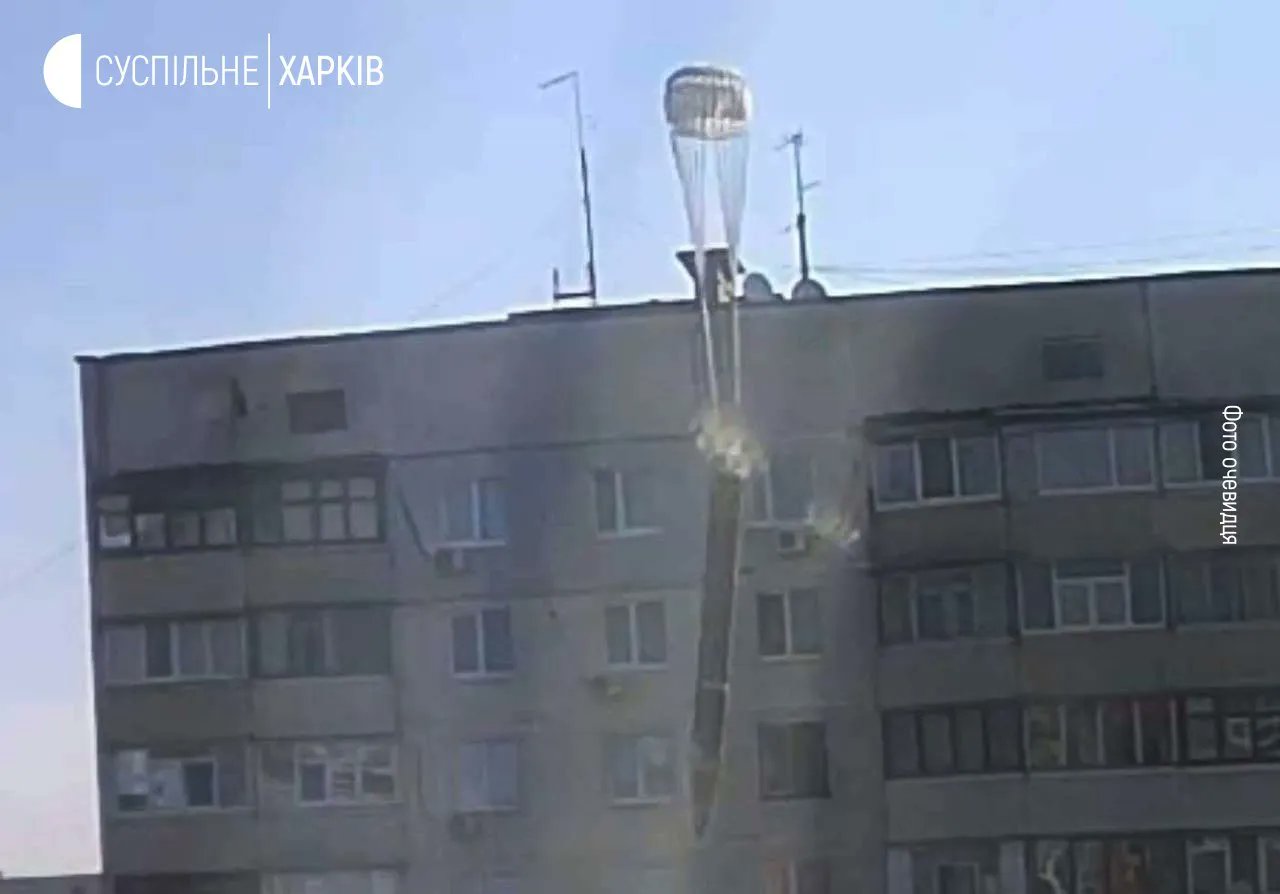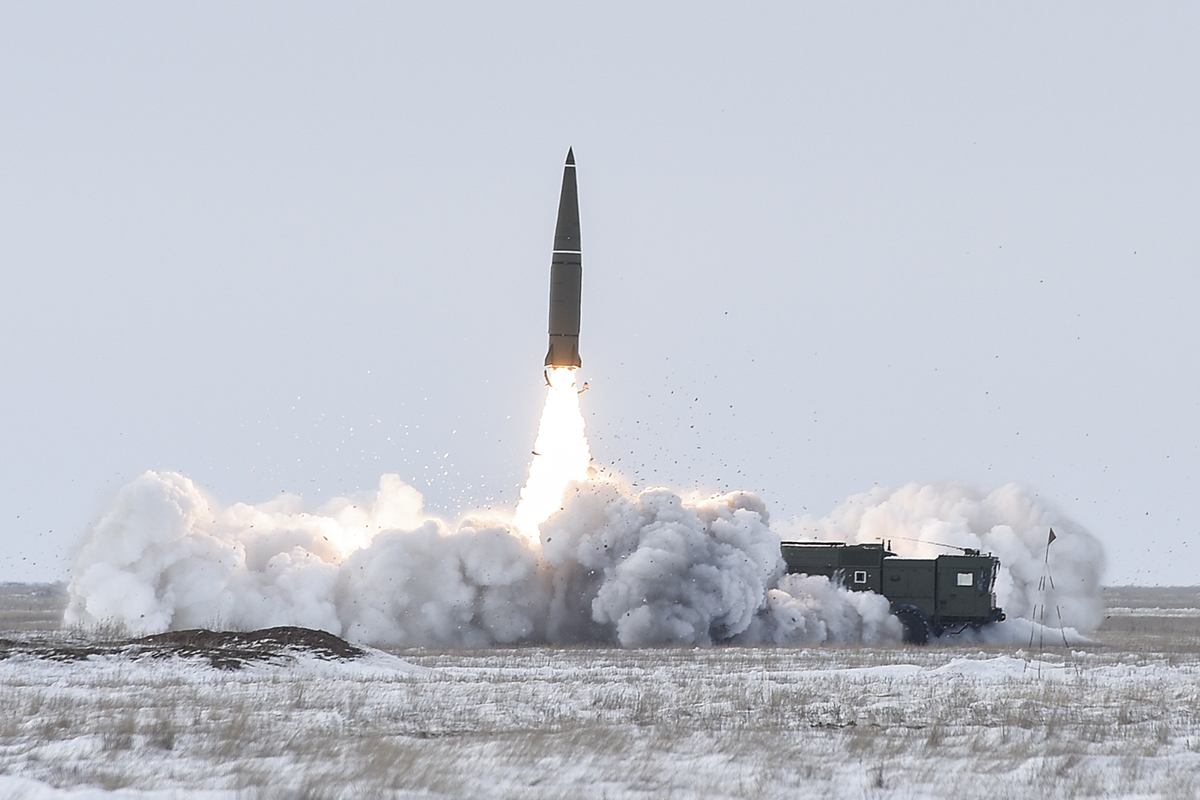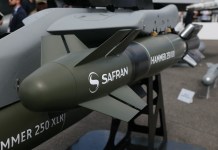Russian troops have begun dropping a new type of bomb in the city of Kharkiv which descends on a parachute according to a recent statement from the Kharkiv City Council.
“The enemy has been bombing Kharkiv for a month and a half. The last two days, along with mines, shells, “Hail”, Kharkiv is facing bombardment with a new type of bomb. The Russian aggressor parachutes them,” said Ihor Terekhov, Kharkiv city Mayor.
A photograph has appeared on social media in which a rocket can be seen descending to the ground by parachute after its launch. The picture appears to be taken moments before the impact.
Judging by the length and diameter of the projectile it looks like a 300 mm rocket fired from a Multiple Rocket Launch System (MRLS) such as BM-30 Smerch or a more advanced Tornado-S system.
The Kharkiv city mayor has asked the residents of the city to remain away from these rockets and notify relevant authorities if they spot one.

“I ask you not to approach them in any case and to inform rescuers about it by phone 101 or 112 at once”, Tereknov noted.
The parachute shells were first reported in the suburbs of Kyiv in mid-March by the Ukrainian Ministry of Internal Affairs.
“Yesterday (March 18) in Kyiv for the first time the fact of using a new type of shells was recorded. It was fired from a Russian multiple launch rocket system. This is a shell that parachuted down to Kyiv,” Anton Gerashchenko, Advisor to the Ministry of Internal Affairs, said during a briefing.
For the first time #Russia dropped parachute bombs (Blockbuster) on #Ukraine (#Kyiv)
prob. from rocket launcher pic.twitter.com/Lwxit5iEJo— C4H10FO2P (@markito0171) March 19, 2022
According to Ukraine’s premier defense magazine, Defense Express, parachutes are used in cluster munitions to ‘scatter’ individual submunitions. The use of parachutes also stabilizes these submunitions and makes sure that they descend vertically with their nose down.
“Some of them, such as the 9M55K1 rocket for the 300-mm Tornado multiple rocket launcher, do use parachutes,” the magazine noted.
The 9M55K1 is a 300 mm rocket that can be fired from Smerch or Tornado-S MRLS. It employs 5 9А349 MOTIV-3M or SPBE- D model anti-tank submunitions to engage moving and stationary armored vehicles.

These submunitions weigh 15 kg each and feature a two-band infrared seeker for terminal guidance and use a top-attack profile to destroy any known armored vehicle, as the armor is usually thinnest on the top of the vehicle. The submunitions are said to be able to penetrate 70 mm armor at an angle of 30° to the normal.
The development and tests of the 9M55K1 rocket were completed in 1994 following which it entered service with the Russian Army in 1996. The rocket has a maximum range of 70 km.

The first confirmed combat uses cluster munitions using Smerch MRLS were recorded in two war zones – Syrian and Ukraine.
In 2014, images of 300mm 9M55K rockets revealed the use of BM-30 Smerch used by Russia against the rebel forces. The rocket carries 72 9N235 fragmentation submunitions.
While, experts from the Armament Research Services (ARES) – a specialist technical intelligence consultancy on matters of arms and munitions – also alluded to the use of the 9M55K1 rocket in the countryside west of Aleppo to deliver an earlier model of the SPBE series submunitions made in 1991.

The submunition was scattered over a wide area putting anyone in the area at the time of the attack, whether combatants or civilians, at risk of death or injury. Also, many of the submunitions do not explode after contact and remain armed becoming de facto landmines.
The Ukrainian government also stands accused by the Human Rights Watch (HRW), of widespread use of cluster munitions in Donetsk and Lugansk during the war in Donbass. An employee of the International Committee of the Red Cross (ICRC) was killed in an attack on Donetsk that included the use of cluster munition rockets.
The HRW field investigation uncovered widespread use of cluster munitions by both government forces and Russian-backed separatists in numerous urban and rural locations. The weapons used were 300 mm Smerch and 220 mm Uragan cluster munition rockets which delivered 9N210 or 9N235 antipersonnel fragmentation submunitions.
“It is shocking to see a weapon that most countries have banned used so extensively in eastern Ukraine,” Mark Hiznay, senior arms researcher at Human Rights Watch said at the time.
“Ukrainian authorities should make an immediate commitment not to use cluster munitions and join the treaty to ban them.”
The use of cluster munitions is banned by the United Nations Convention on Cluster Munitions. To date. To date, 110 countries are parties to the Convention.
- Written by Tanmay Kadam/EurAsian Times Desk
- Contact the author at etdesk@eurasiantimes.com
- Follow EurAsian Times on Google News




